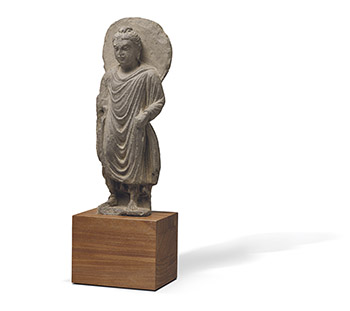Catalogue Note
The Buddha wears a loose coat covering both shoulders and falling in folds over the body. He stands barefooted on a square plinth, and his facial features are both delicately handsome and solemn. His wavy hair is combed back and gathered into a bun (ushnisha) on the top of his head. In the middle of his forehead, between the eyebrows, is the baihao (white hair), a little round spot or curl which is a symbol of the Buddha. His almond-shaped eyes are looking downward, and his mouth is firmly closed. Behind and above him is a disc-shaped halo without any decorative patterns.
The ancient Gandhara region is one of the cradles of Buddhism, roughly located in the area of modern Pakistan. The statues from this region blend the aesthetic styles of ancient Greece, Rome, and India, and are important historical, religious, and artistic artifacts. During the past 100 years, Japanese, European, and North American museums and collectors have been shelling out large sums of money to acquire Gandhara statues. Unfortunately, Chinese collectors have not been aware of this development so far. These statues are also seminal artifacts in the context of Buddhist art along the Silk Road: with their magnificent beauty and brilliant splendor, they have had a considerable impact on the development of Buddhist art in China.
Even though China today is one of the main centers of Buddhist culture in Eastern Asia, Chinese knowledge and understanding of Gandhara and its culture is still very much in its infancy. However, the deep influence Gandhara has had on China's ancient art and culture, as well as the aesthetic values it imparted on the Middle Kingdom, will certainly be recognized and acknowledged by collectors once they set their sights on these artifacts which are part of the world's cultural heritage. Together with China's ancient art and culture, Gandhara forms an important building block of ancient Buddhist civilization.
The ancient Gandhara region is one of the cradles of Buddhism, roughly located in the area of modern Pakistan. The statues from this region blend the aesthetic styles of ancient Greece, Rome, and India, and are important historical, religious, and artistic artifacts. During the past 100 years, Japanese, European, and North American museums and collectors have been shelling out large sums of money to acquire Gandhara statues. Unfortunately, Chinese collectors have not been aware of this development so far. These statues are also seminal artifacts in the context of Buddhist art along the Silk Road: with their magnificent beauty and brilliant splendor, they have had a considerable impact on the development of Buddhist art in China.
Even though China today is one of the main centers of Buddhist culture in Eastern Asia, Chinese knowledge and understanding of Gandhara and its culture is still very much in its infancy. However, the deep influence Gandhara has had on China's ancient art and culture, as well as the aesthetic values it imparted on the Middle Kingdom, will certainly be recognized and acknowledged by collectors once they set their sights on these artifacts which are part of the world's cultural heritage. Together with China's ancient art and culture, Gandhara forms an important building block of ancient Buddhist civilization.
